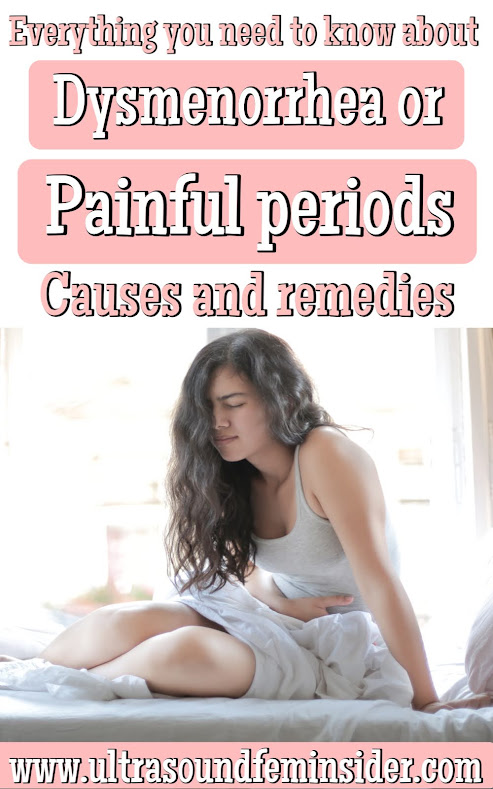Are you one of those women that every month during your period can’t work, exercise or carry a normal life due to debilitating menstrual cramps? If your answer is yes, let me tell you that this condition is known as dysmenorrhea. In simple words Dysmenorrhea is the medical terminology that refers to painful menstrual cramps, those cramps are caused by contractions in the uterus. In this article we’ll talk about Dysmenorrhea. Causes, symptoms and most importantly, remedies that will make you feel better right away. Ready? Let’s begin.
What is dysmenorrhea, commonly known as menstrual cramps?
As I mentioned previously dysmenorrhea is the medical term for pain with your periods or severe menstrual cramps. There are two types of dysmenorrhea: primary and secondary.
Primary dysmenorrhea: Is when your cramps keep coming back (recurring). They aren’t caused by any other illnesses. Pain usually starts one or two days before you get your period or when you start to bleed. You might feel pain in your lower abdomen, back, or thighs. It could be mild or very bad. For most woman, pain can last from 12 to 72 hours. You might also have other symptoms like nausea or diarrhea. If you have a baby, your menstrual cramps may not be as bad as they used to be.
Secondary dysmenorrhea: Is when you have painful periods because you have a disorder or an infection in your female reproductive organs, which makes them hurt. Secondary dysmenorrhea can cause pain that lasts longer than normal menstrual cramps. It usually starts earlier in the cycle and lasts longer than normal cramps. You don’t usually get nausea, vomiting, tiredness, or diarrhea when you eat.
Causes for menstrual cramps to be so painful.
When a substance called prostaglandin causes the uterus to contract, it causes menstrual cramps (tighten up). During your menstrual cycle, the uterus, the muscle organ where a baby grows, contracts. The uterus contracts more vigorously during menstruation. When the uterus contracts excessively hard, it can press against adjacent blood arteries, cutting off oxygen supply to muscular tissue. When a muscle loses its supply of oxygen for a short period of time, it causes discomfort.
Menstrual cramps are caused by Secondary dysmenorrhea in a variety of ways.
Secondary dysmenorrhea causes menstrual pain as a result of diseases with the reproductive organs. Cramping can be caused by a variety of factors, including:
- Fibroids (benign tumors) are benign tumors that grow on the inside, outside, or inside the uterine walls.
- Endometriosis is a condition in which the endometrium (the tissue from the cavity of the uterus) grows outside of the uterus. These bits of tissue can cause swelling, scarring, and pain since they bleed during your period as well.
- PID (pelvic inflammatory disease) is a bacterial infection that begins in the uterus and spreads to other reproductive organs. PID can induce stomach pain as well as Dyspareunia (pain during sex).
- Adenomyosis is a disorder in which the uterine lining develops into the uterine muscle (myometrium). This disorder can result in the uterus becoming significantly larger than it should be, as well as abnormal bleeding and pain.
- Cervical stenosis is a narrowing of the cervix, or uterine opening.
How do you know if you’re having dysmenorrhea?
The most common signs and symptoms if you are suffering from dysmenorrhea are:
- A throbbing discomfort in the stomach (pain may be severe at times).
- In the abdomen, there is a feeling of pressure.
- Hips, lower back, and inner thighs ache.
When to be concerned and seek medical attention?
Contact your healthcare practitioner if you have severe or atypical menstrual cramps or cramps that continue longer than two or three days. It’s important to get checked because both primary and secondary menstrual cramps can be treated.
You will first be asked to describe your symptoms as well as your menstrual cycles. A pelvic exam will also be performed by your healthcare provider. A speculum (an instrument that lets the provider see inside the vagina) must be inserted during this examination. Your vaginal, cervix, and uterus can all be examined by the provider. Any lumps or alterations will be felt by the doctor. A tiny sample of vaginal fluid may be taken for testing as well.
Additional tests, like as an ultrasound or a laparoscopy, may be required if your doctor suspects you have secondary dysmenorrhea. If the tests reveal a medical problem, your doctor will discuss treatment options with you.
If you use tampons, due to a life-threatening illness known as Toxic shock syndrome, and you experience any of the following symptoms, you need to get medical attention right away:
- Fever (more than 102 degrees).
- Vomiting.
- Diarrhea.
- Dizziness, fainting, or near-fainting are all symptoms of vertigo.
- A rash that appears to be sunburned.
Remedies for dysmenorrhea.
Always remember that the root cause of dysmenorrhea needs to be addressed first in order to get long lasting relief. If the reason of the dysmenorrhea are fibroids, endometriosis, adenomyosis or any other medical condition then all these remedies will help temporarily. However, these are some things you can do in the meantime that are effective to get alleviated. If testing reveals that you have secondary dysmenorrhea, your doctor will address the issue that is causing the pain and how to manage it. Oral contraceptives, other types of drugs, or surgery may be used.
To ease mild menstrual cramps, you can try the following:
- Take ibuprofen as soon as the bleeding or cramping begins for the best results. Ibuprofen belongs to the non-steroidal anti-inflammatory medicine (NSAID) class of medications (NSAIDs). They inhibit the production of prostaglandins. If you can’t use NSAIDs, another pain killer like acetaminophen can be used instead.
- Apply heat to your lower back or abdomen with a heating pad or a hot water bottle.
- When needed, take a break.
- Caffeine-containing foods should be avoided.
- Avoid smoking and consuming alcoholic beverages.
- Massaging your lower back and abdomen is always a good idea.
- Menstrual pain is often reduced in women who exercise regularly. Therefore, make exercising a part of your weekly routine to help prevent cramping.
If these measures don’t help your pain, your doctor may prescribe drugs, such as ibuprofen or another anti-inflammatory prescription in a greater dose than what’s available over the counter. Oral contraceptives may also be recommended by your healthcare practitioner, as women who use them experience less menstrual pain.
Share this article.

What kinds of alternative therapies can help with menstrual cramps?
Women with painful periods frequently seek out natural remedies to alleviate their discomfort. Alternative or supplementary methodology studies have not yielded compelling findings. Keep in mind that the FDA does not regulate most supplements. You might also find the following methods useful:
- Yoga.
- Massage.
- Acupuncture and acupressure are two types of acupuncture.
- Breathing or relaxation exercises such as Meditation.
Related articles you might want to check after.
Adenomyosis, symptoms, causes and treatment.
All about Polycystic ovarian syndrome or PCOS.
Hemorrhagic cyst. Cause, symptoms, complications, ultrasound.
Ovaries, hormonal cycles and common cysts.
Pelvic pain in women. Role of ultrasound diagnosing pelvic pain.
Final thoughts about Dysmenorrhea.
Menstruation is a natural part of life. You may get cramps, but you do not have to suffer in silence. There are a few things you may do to make painful periods go away. Make an appointment with your doctor to discuss your painful periods. Some women are unable to work or attend school due to severe cramping. Again, you don’t have to suffer or put your life on hold if you don’t want to. If you’re having trouble with your periods, go to your doctor.
I hope this article was helpful to some of you. If you have any question, feel free to ask below.
Zadi, xo
Disclaimer: The medical information on this post is for educational and entertainment use only. Under no circumstances, this information is to replace your doctor’s advice or to treat any disease. For proper care, always visit your doctor.










Outstanding information as usual!! Keep up the great work, I always comeback to get good information about health. I suffer of painful periods before, thanks.
I am happy to help. Dysmenorrhea is something that affects many women around the world.
[…] Dysmenorrhea. Causes, symptoms and remedies. […]